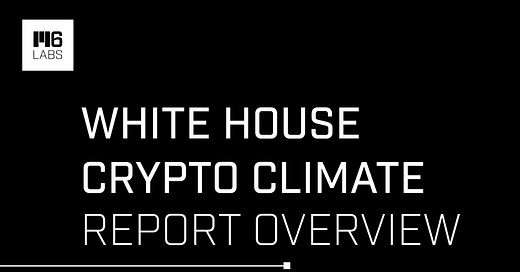White House Crypto Climate Report Overview
The White House Office of Science and Technology Policy released a report about the climate and energy implications of crypto-assets in the US
Recently, The White House Office of Science and Technology Policy (OSTP) released a report about the climate and energy implications of crypto-assets in the US.
Let’s unwrap the main takeaways from it in simple terms.
Before we get started... Want early access to our research threads? Sign up to our Substack to receive daily coverage on everything you need to know about going on in the crypto directly in your inbox:
Done? Now let's dive in!
The report underscores the damage that climate change is doing to human health, the environment, and the economy, insisting on solving these problems by reducing anthropogenic greenhouse gas
And Proof-of-Work cryptos such as Bitcoin stay in the way of solving these problems
US electricity usage doubled and quadrupled from 2018 to 2022. Crypto mining uses between 0.4 and 0.9 percent of global energy. The report implies that crypto mining uses too much energy & needs to transition to renewable energy sources.
What is the environmental impact of digital assets and mining?
Global electricity for the crypto assets with the largest market cap accounts for 0.3% of GHG emissions. The report does not specify how many cryptos are included in this calculation and how they came up with it.
What are the potential uses of blockchain technology?
Distributed Ledger Technologies could potentially enable distributed energy resource coordination and improve broader supply chain management.
What critical policy decisions/R&D are needed to minimize the environmental impact?
Crypto policy should reduce GHG emissions and avoid operations that will increase the cost of electricity to consumers. Also, to avoid operations that reduce the reliability of electric grids.
Should these measures prove ineffective at reducing impacts, the administration will explore executive actions and congress might consider legislation to limit or eliminate the use of high energy intensity consensus mechanisms for crypto asset mining.
Another recommendation is to ensure that crypto mining doesn't disrupt energy supplies and requires miners to collect data to understand, monitor, and mitigate impacts. This creates centralization risks.
The authors also emphasize the advancement of energy efficiency standards which involve regularly updating environmental requirements for crypto mining. Authors reiterate that crypto mining could threaten the current administration's climate agenda.
The second part of the report covers the electricity usage of crypto. It discusses the difference in energy use between crypto and the financial system. Pointing out to 2 counties in Washington that had energy grid issues because of mining, as proof that their concerns are valid.
Authors point to Europe’s scrutiny of crypto mining as proof that their policy recommendations are correct and seem to imply that China's total crackdown on crypto mining is the way to go in the US.
The authors go on to analyze the composition of energy sources in the US and make another claim: one year of US crypto asset GHG emissions at this rate is equivalent to the annual emissions from more than three million gasoline-powered cars for a year of average US travel.
The authors note that mining minerals and producing steel and other materials for computing equipment also emit GHGs. The majority of emissions associated with crypto assets come from electricity generation to run crypto asset mines.
Then they finally admit that there are 2 ways crypto mining can be used to achieve net zero emissions - the 1st is to create a base load of demand for renewable energy sources so that they can expand and the second is to ensure efficient operations of renewable energy grids.
The authors fear that crypto mining could misalign the economics of renewable energy with renewable energy suppliers purposely setting up their operations to make more money from the crypto miners rather than selling it to local communities.
Last but not least, the authors tackle electronic waste which is a real concern when it comes to the specialized ASIC machines used in crypto mining. As they can't be used for anything else once they have reached the end of their average shelf life of 2 years.
Interestingly the authors don't seem to be that worried about the e-waste associated with crypto-mining partially because it's an issue faced in other industries as well and partially because they seem to believe that ASIC miners could be recycled for their critical minerals.
The authors also discuss how DLTs can support climate monitoring/mitigation. DLT adoption in environmental markets should make sure that environmental benefits are sufficient in comparison to the environmental impact of current market infrastructure technology.
Watch this great video from CoinBureau about this report:
Read the full White House Crypto Climate Report here.
Subscribe to receive our daily brief, extended weekly newsletter, and in-house research content!
Please Share, Leave Feedback, and Follow Us on Twitter, Telegram, and LinkedIn to stay connected with us.




